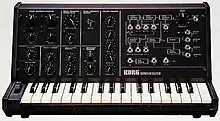Korg MS-10
Korg MS-10 is an analogue synthesizer created by Korg in 1978.[2] Unlike its bigger brother, the Korg MS-20, the MS-10 only has one VCO, one VCF and one envelope generator. It is monophonic and has 32 keys.
| MS-10 | |
|---|---|
 Korg MS-10 | |
| Manufacturer | Korg |
| Dates | 1978–1981[1] |
| Price | US$450 |
| Technical specifications | |
| Polyphony | Monophonic |
| Timbrality | Monotimbral |
| Oscillator | 1 VCO per voice Triangle, Sawtooth, Pulse width, White noise |
| Synthesis type | Analog subtractive |
| Filter | 1 low-pass |
| Aftertouch expression | no |
| Velocity expression | no |
| Storage memory | none |
| Effects | none |
| Input/output | |
| Keyboard | 32 keys |
| External control | CV/Gate |
The MS-10 is well known for its huge sounding electro bass sounds.[3]
Architecture
Oscillator
The MS-10 has one VCO with 4 waveforms: triangle, sawtooth, pulse, and white noise.
Filter
The MS-10 has the same "KORG35" 12 dB/Oct low pass filter as the original MS-20.[4][5] Resonance ("peak" in Korg parlance) is adjustable but not voltage-controlled.
Originally, the filters used Korg's proprietary KORG-35 thick film IC. Later, the filters were redesigned to use off-the-shelf LM13600 OTAs.
A useful illustration of the Korg-35 filter in-circuit is shown here [6] and some photographs illustrating the later LM13600 filter daughterboard are shown here.[7] The tonal difference between the two is that the original Korg-35 filter has a slight amount of hiss which overdrives into the sound at high resonant settings. This causes the filter to have more of a "screaming" effect similar to it being used with a distortion pedal. The revised filter has most of this noise cleared up and is less aggressive sounding.
Output
There is a simple single transistor VCA. The amplitude of the VCA can be controlled by the envelope generator.
Modulation generator
The MS-10 has one LFO, labelled "modulation generator". It has two controls (rate and shape) and two outputs (pulse and sloped).
The shape control affects the pulse width and the shape of the sloped output. At midway, the pulse width is 50% and the output is a triangle wave. Both outputs are available through the patch panel and can be used for triggering the envelope generators – the pulse wave with a key held down, and the sloped without. The depth of LFO modulation of the VCO frequency and the filter cut-off can be controlled from knobs in the respective sections of the control panel.
Envelope
There is one envelope generator with controls for Hold, Attack, Decay, Sustain and Release.
Patching
Although the MS-10 has normalized connections, they can be modified with patch cables. This allows the LFO to modulate the pulse width (which is called pulse-width modulation, or PWM) of the VCO or the amplitude of the VCA. It also has a noise generator with white and pink noise outputs, CV in and out, and an external signal input (not to be confused with the "External Signal Processor" of the MS-20).
Compatibility with other synths and modules
The MS-10's VCO uses linear voltage control (Hz/Volt) but note that V/oct scaling (−5V to +5V) is available via judicious use of the "freq" CV input socket. A CV converter can also be used.
Notable users
- Abstract Lion
- Add N to (X)
- Astral Projection
- Autechre
- Chemical Brothers
- Jean-Michel Jarre
- Juan Atkins
- Junoto
- Junkie XL
- Luke Vibert
- Nitro Pulse
- The Orb
- Paul Evolution
- Pet Shop Boys
- Puce Mary
- SkyLab
- Sneaker Pimps
- Towa Tei
- Underworld
References
- "Top Ten Most Underrated Synths - Page 2 of 11 - Attack Magazine". Attack Magazine. 2012-09-19. Retrieved 2018-08-10.
- "Korg MS-10 | Vintage Synth Explorer".
- "Top Ten Most Underrated Synths - Page 2 of 11 - Attack Magazine". Attack Magazine. 2012-09-19. Retrieved 2018-08-10.
- http://www.timstinchcombe.co.uk/synth/MS20_study.pdf
- "A-106". Doepfer.de. 2010-06-18. Retrieved 2013-10-07.
- "Archived copy". www.punkdisco.co.uk. Archived from the original on 19 June 2015. Retrieved 12 January 2022.
{{cite web}}: CS1 maint: archived copy as title (link) - "KORG MS-20 "VERSION 2"". Nwheaton.homemail.com.au. 2006-05-11. Retrieved 2013-10-07.